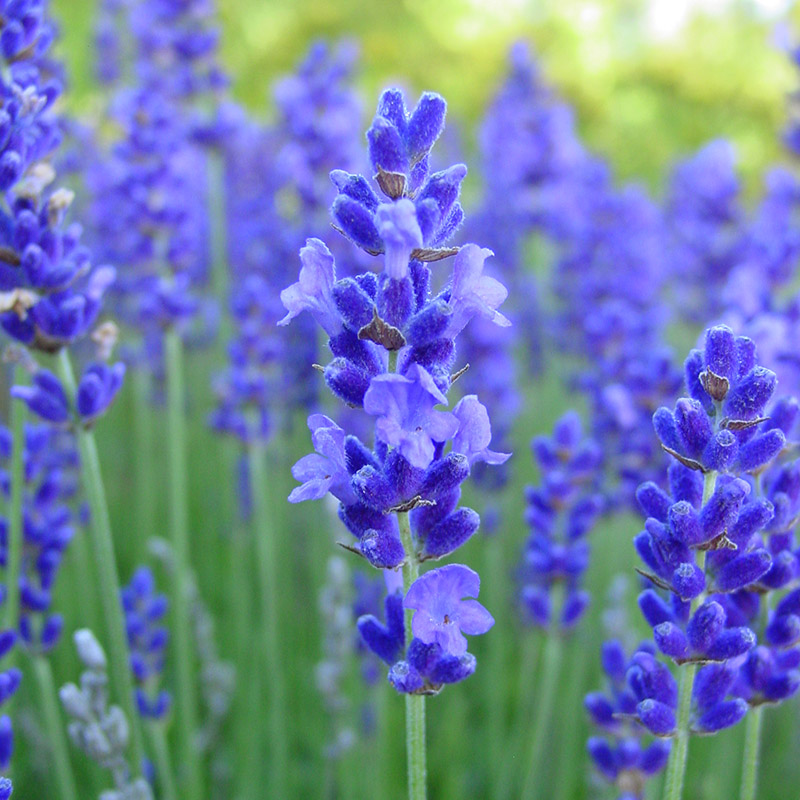Botanical name
Lavandula angustifolia Mill.
Family
Lamiaceae
Common name
Common lavender, English lavender, Garden lavender
Information about the plant
The heat-loving lavender is native to the Mediterranean region, where it is cultivated on a large scale. The name Lavandula - Lavender is derived from its earlier widespread use as a fragrant addition to bath water (lavare, Latin = to wash). The species epithet angustifolia (Latin = narrow-leaved) refers to its narrow leaves.
The pleasantly aromatic and fragrant lavender is a 30 to 60 cm high shrub with narrow, blue-green leaves approximately 5 cm long. The lower leaves have small white hairs, and their edges are more or less rolled. The flowers are arranged in dense whorls at the end of long stems, forming a pseudo-spike. The blue-violet corolla consists of a bilobed upper lip and a slightly smaller three-lobed lower lip, which emerge from the tubular, oval, blue-gray calyx. When dried, the corolla falls off easily or shrinks considerably, leaving only the calyx visible. Lavender fields bloom from late July to August.
Medicinally used parts of plants (herbal drug)
The flowers, stripped from the stem (lavender flowers - Lavandulae flos) with their pleasantly sweet fragrance, are used. The fragrance is caused by the essential oil contained in glandular scales on the flower surface. When rubbed, these glands release the essential oil. Lavender oil (Lavandulae aetheroleum) is also used medicinally.
The commercially available drug is sourced from France, Spain, and Eastern Europe.
Constituents of the herbal drug
Lavender flowers contain essential oil (lavender oil), with linalyl acetate and linalool as the main components, along with other monoterpenes. The flowers also contain lamiaceous tannins.
Quality of the drug
The quality of the following drugs or drug preparations is specified in the European Pharmacopoeia (Ph. Eur.):
- Lavender flowers (Lavandula flos)
- Lavender Oil (Lavandula aetheroleum)
Medical applications
Recognised medical use
The HMPC has classified lavender flowers and lavender oil as traditional herbal medicinal products (see “Traditional use”).
ESCOP: Lavender flowers and lavender oil are used for mood swings such as restlessness, agitation, or sleep disorders, as well as for functional abdominal complaints.
Indications for the use of lavender oil (approval) confirmed by clinical studies: for the treatment of restlessness in anxious moods.
In aromatherapy, lavender oil is used for its calming effects - also by midwives in obstetrics. It is also a good repellent (e.g., for mosquitoes). Apply undiluted or mixed 1:1 with alcohol.
Traditional use
Lavender flowers and lavender oil have been classified by the HMPC as traditional herbal medicinal products (Article 16a of Directive 2001/83/EC). Based upon long-standing use, lavender flowers and lavender oil can be used to treat mild symptoms of stress and exhaustion, as a sleep aid, and externally as a bath additive.
Herbal drug preparations in finished dosage forms
- Lavender flowers as tea, also as tea bags and in combination with other drugs, and as an additive to baths
- Lavender oil in soft capsules
- Lavender oil in baths
Dosage
Finished medicinal product: see patient information leaflet.
Tea: Adults and adolescents can drink 1 cup of warm lavender tea several times a day.
Lavender oil: Adults and adolescents can take 1 - 4 drops several times a day on a lump of sugar or in water.
As a bath additive, add 10 to 100 g of lavender flowers or 1 to 3 g of lavender oil to a full bath (bath duration: 10 to 20 minutes).
Preparation of a tea
Pour 150 mL of hot water over 1 to 2 g of lavender flowers (do not boil!), leave to infuse for 5 to 10 minutes and strain.
Notes
In infants and small children up to 2 years of age, lavender oil can induce a glottis spasm (laryngospasm), potentially causing respiratory arrest. Therefore, lavender oil should never be applied to the face! As a precautionary approach, it is not recommended for use in children under 4 years of age.
Full baths should not be taken in case of open wounds, extensive skin inflammation, other skin diseases, fever, circulatory problems, and cardiac insufficiency.
No safety studies are available on the use of lavender flowers during pregnancy and lactation. The use of lavender flowers in children under 12 years of age is not recommended due to a lack of evidence; this also applies to the use of lavender oil in children and adolescents under 18 years of age.
Side effects
If lavender oil is used internally, it can cause belching and nausea (usually temporary).
Interactions
None known.
References
Herbal drug monographs
HMPC (2012, 2021), ESCOP (2009), WHO Vol. 3
Further literature
Commentary on the European Pharmacopoeia (Lavender flowers, No. 1534; Lavender oil, No. 1338)


